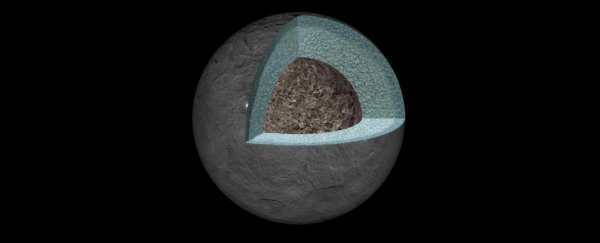NASA researchers are using a new technique to figure out what the mysterious dwarf planet Ceres, with its weird bright spots, is made of… and their results suggest it's even stranger than expected.
The data so far indicate that Ceres is less dense than many of the other rocky bodies inside the Solar System, and that the dwarf planet is 'differentiated', meaning that it's made up of different layers that get denser and denser until reaching its core.
"We have found that the divisions between different layers are less pronounced inside Ceres than the Moon and other planets in our Solar System," Ryan Park, from NASA's Jet Propulsion Laboratory, said in a statement. "Earth, with its metallic core, semi-fluid mantle and outer crust, has a more clearly defined structure than Ceres."
To tease out some of these details, the team used a new technique that involved analysing the motion data collected during the Dawn mission.
The Dawn probe will be visiting three dwarf planets in total, and is currently in orbit around Ceres.
Using data it's collected on Ceres' gravitational pull, the team was able to map the gravitational field of the dwarf planet, providing valuable insight as to what might be lurking under the surface.
"Ceres' gravity field is measured by monitoring radio signals sent to Dawn, and then received back on Earth, by NASA's Deep Space Network," the team explains.
"This network is a collection of large antennae at three locations around the globe that communicate with interplanetary spacecraft. Using these signals, scientists can measure the spacecraft's speed to a precision of 0.004 inches (0.1 millimetres) per second, and then calculate the details of the gravity field."
After creating the map, the team then analysed how the dwarf planet's structure and shape could play a role in these gravitational variations.
In the end, they concluded that the rocky body is in 'hydrostatic equilibrium' - meaning that is has a weak interior - allowing the dwarf planet to change shape depending on its rotation, kind of like how clay can change shape when spun at high speeds.
The researchers also found that 'high elevation areas' - which you can think of as mountains - displace mass inside Ceres core. As these mountains shift, they basically 'float' on top of the materials below them, pushing them out of the way like a boat displaces water.
One of the coolest hypotheses the team came up with was that Ceres probably had mobile subsurface water in its early days, and for some reason, the dwarf planet never got hot enough to melt its silicates, meaning it never developed a metallic core like other rocky planets.
"The new data suggest that Ceres has a weak interior and that water and other light materials partially separated from rock during a heating phase early in its history," said Park.
While the new study certainly provides a bunch of new details about the interior structure of Ceres, the team still has a lot of work to do before they can understand all of the complex thermal activities that took place, and how they fit together to produce the Ceres we know today.
And one day, they might even solve one of the biggest mysteries surrounding Ceres: where exactly did it come from? Watch this space.
The findings have been published in Nature.
